Detailed Management Accounting Report: Zylla Company Analysis
VerifiedAdded on 2020/07/23
|18
|4423
|39
Report
AI Summary
This report provides a comprehensive analysis of management accounting principles and their application within Zylla Company, a manufacturing firm. It defines management accounting, explores different types of management accounting systems like cost accounting, inventory management, job costing, and price optimization, and their respective requirements. The report delves into various methods of management accounting reporting, including accounts receivable ageing, stock management, segmental reports, operating budget reports, and job costing reports. It demonstrates cost calculation using marginal and absorption costing techniques to prepare income statements, including the relevant workings. Furthermore, the report explains the advantages and disadvantages of different planning tools used in budgetary control, specifically zero-based budgeting. Finally, it outlines how organizations can use management accounting to respond to financial problems, offering insights into financial planning, revaluation accounting, and fund flow statements.
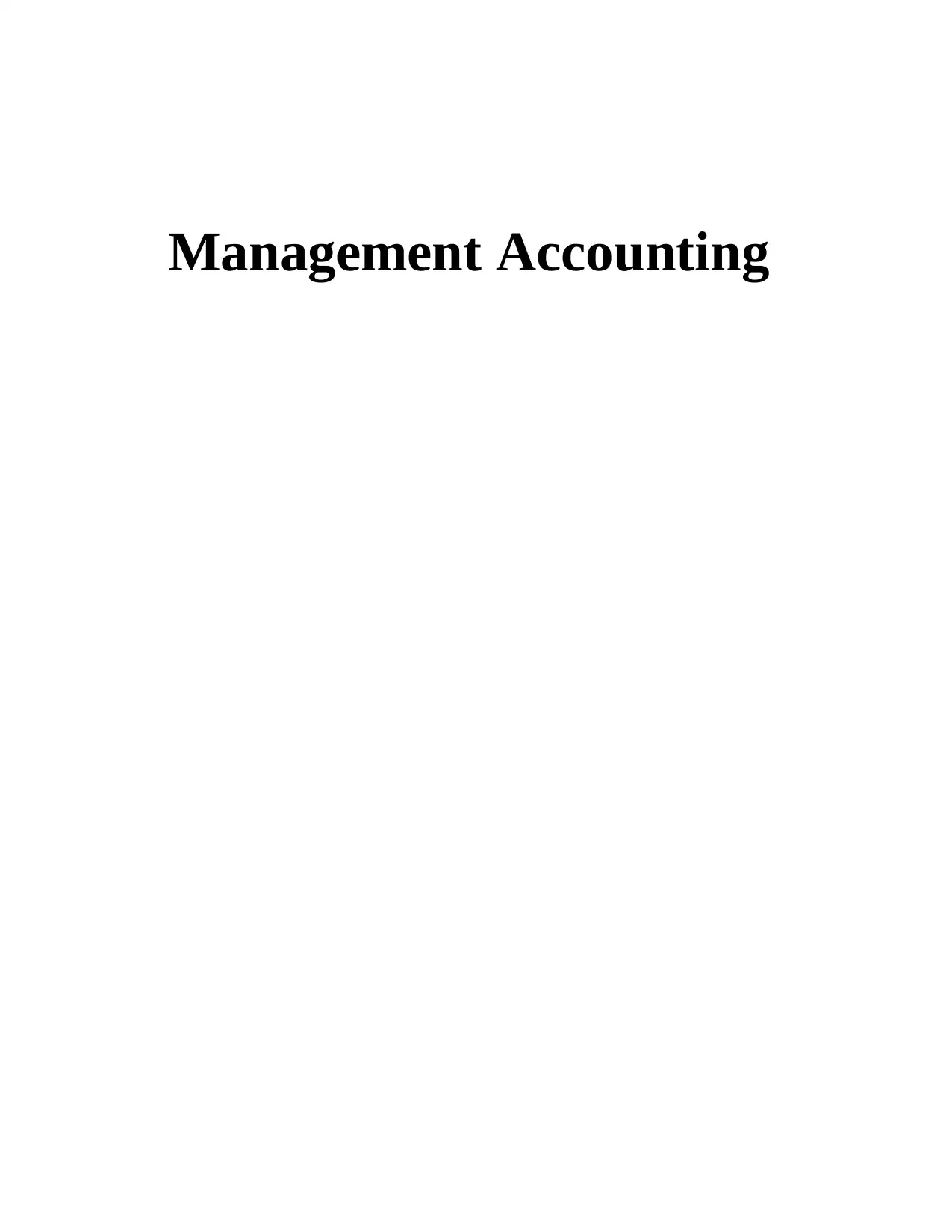
Management Accounting
Paraphrase This Document
Need a fresh take? Get an instant paraphrase of this document with our AI Paraphraser
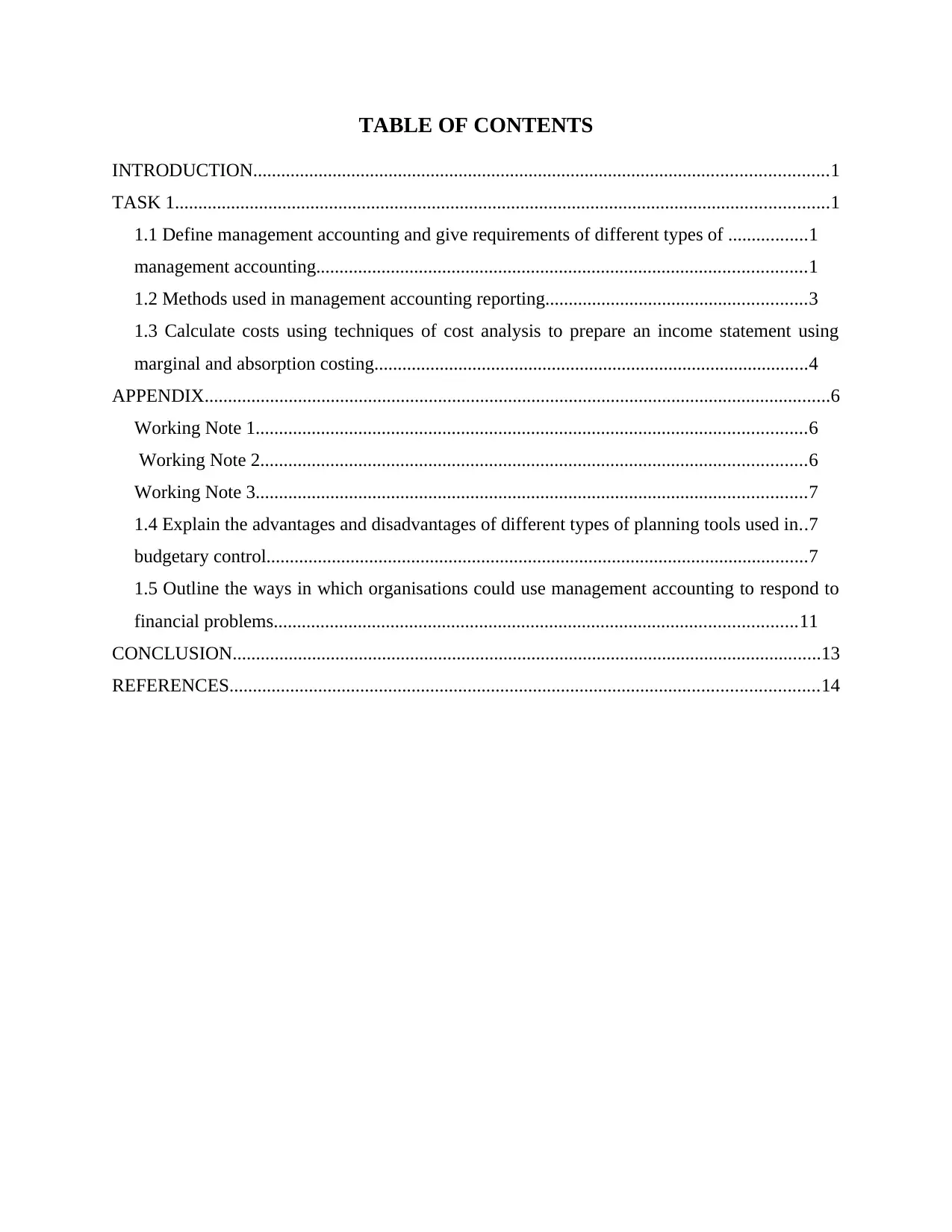
TABLE OF CONTENTS
INTRODUCTION...........................................................................................................................1
TASK 1............................................................................................................................................1
1.1 Define management accounting and give requirements of different types of .................1
management accounting.........................................................................................................1
1.2 Methods used in management accounting reporting........................................................3
1.3 Calculate costs using techniques of cost analysis to prepare an income statement using
marginal and absorption costing.............................................................................................4
APPENDIX......................................................................................................................................6
Working Note 1......................................................................................................................6
Working Note 2.....................................................................................................................6
Working Note 3......................................................................................................................7
1.4 Explain the advantages and disadvantages of different types of planning tools used in..7
budgetary control....................................................................................................................7
1.5 Outline the ways in which organisations could use management accounting to respond to
financial problems................................................................................................................11
CONCLUSION..............................................................................................................................13
REFERENCES..............................................................................................................................14
INTRODUCTION...........................................................................................................................1
TASK 1............................................................................................................................................1
1.1 Define management accounting and give requirements of different types of .................1
management accounting.........................................................................................................1
1.2 Methods used in management accounting reporting........................................................3
1.3 Calculate costs using techniques of cost analysis to prepare an income statement using
marginal and absorption costing.............................................................................................4
APPENDIX......................................................................................................................................6
Working Note 1......................................................................................................................6
Working Note 2.....................................................................................................................6
Working Note 3......................................................................................................................7
1.4 Explain the advantages and disadvantages of different types of planning tools used in..7
budgetary control....................................................................................................................7
1.5 Outline the ways in which organisations could use management accounting to respond to
financial problems................................................................................................................11
CONCLUSION..............................................................................................................................13
REFERENCES..............................................................................................................................14
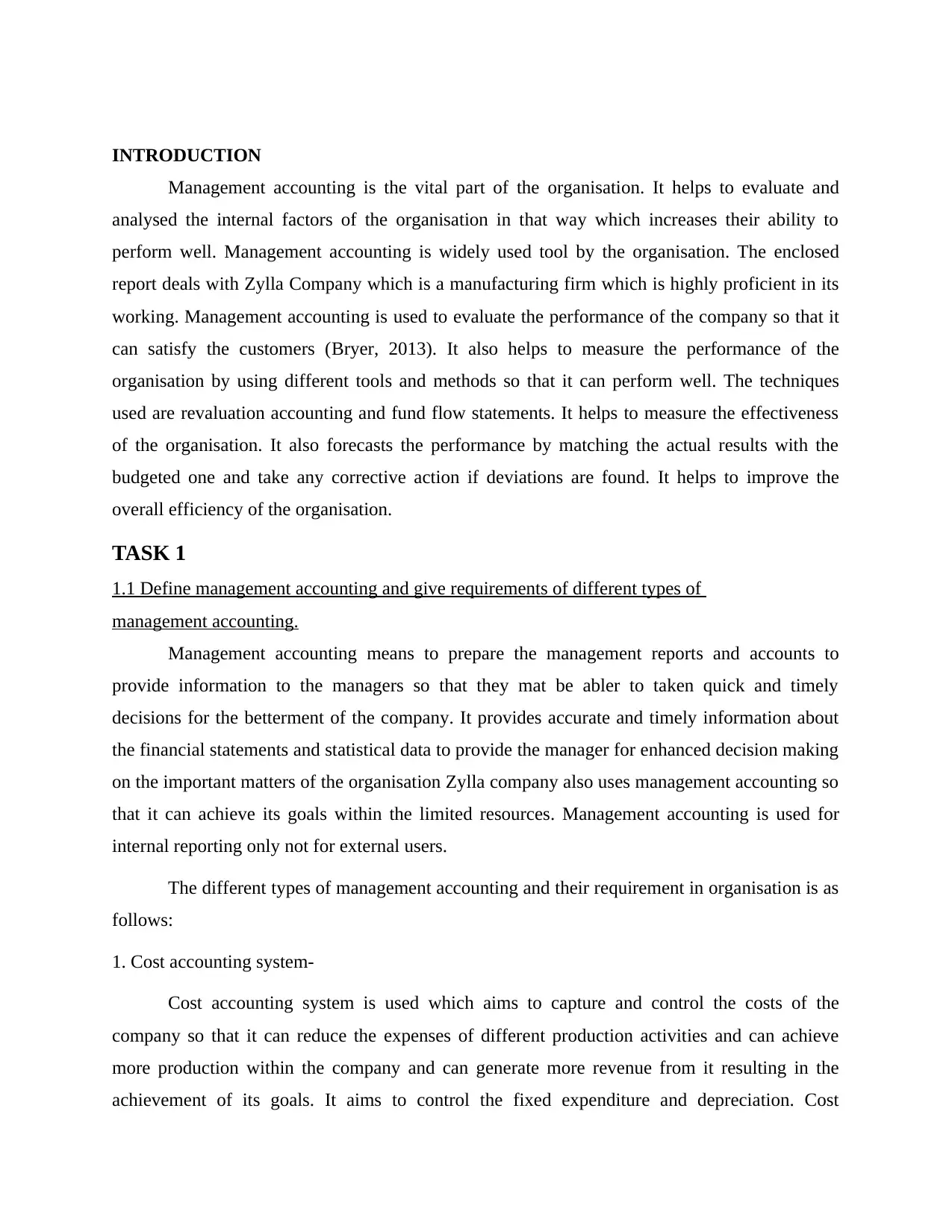
INTRODUCTION
Management accounting is the vital part of the organisation. It helps to evaluate and
analysed the internal factors of the organisation in that way which increases their ability to
perform well. Management accounting is widely used tool by the organisation. The enclosed
report deals with Zylla Company which is a manufacturing firm which is highly proficient in its
working. Management accounting is used to evaluate the performance of the company so that it
can satisfy the customers (Bryer, 2013). It also helps to measure the performance of the
organisation by using different tools and methods so that it can perform well. The techniques
used are revaluation accounting and fund flow statements. It helps to measure the effectiveness
of the organisation. It also forecasts the performance by matching the actual results with the
budgeted one and take any corrective action if deviations are found. It helps to improve the
overall efficiency of the organisation.
TASK 1
1.1 Define management accounting and give requirements of different types of
management accounting.
Management accounting means to prepare the management reports and accounts to
provide information to the managers so that they mat be abler to taken quick and timely
decisions for the betterment of the company. It provides accurate and timely information about
the financial statements and statistical data to provide the manager for enhanced decision making
on the important matters of the organisation Zylla company also uses management accounting so
that it can achieve its goals within the limited resources. Management accounting is used for
internal reporting only not for external users.
The different types of management accounting and their requirement in organisation is as
follows:
1. Cost accounting system-
Cost accounting system is used which aims to capture and control the costs of the
company so that it can reduce the expenses of different production activities and can achieve
more production within the company and can generate more revenue from it resulting in the
achievement of its goals. It aims to control the fixed expenditure and depreciation. Cost
Management accounting is the vital part of the organisation. It helps to evaluate and
analysed the internal factors of the organisation in that way which increases their ability to
perform well. Management accounting is widely used tool by the organisation. The enclosed
report deals with Zylla Company which is a manufacturing firm which is highly proficient in its
working. Management accounting is used to evaluate the performance of the company so that it
can satisfy the customers (Bryer, 2013). It also helps to measure the performance of the
organisation by using different tools and methods so that it can perform well. The techniques
used are revaluation accounting and fund flow statements. It helps to measure the effectiveness
of the organisation. It also forecasts the performance by matching the actual results with the
budgeted one and take any corrective action if deviations are found. It helps to improve the
overall efficiency of the organisation.
TASK 1
1.1 Define management accounting and give requirements of different types of
management accounting.
Management accounting means to prepare the management reports and accounts to
provide information to the managers so that they mat be abler to taken quick and timely
decisions for the betterment of the company. It provides accurate and timely information about
the financial statements and statistical data to provide the manager for enhanced decision making
on the important matters of the organisation Zylla company also uses management accounting so
that it can achieve its goals within the limited resources. Management accounting is used for
internal reporting only not for external users.
The different types of management accounting and their requirement in organisation is as
follows:
1. Cost accounting system-
Cost accounting system is used which aims to capture and control the costs of the
company so that it can reduce the expenses of different production activities and can achieve
more production within the company and can generate more revenue from it resulting in the
achievement of its goals. It aims to control the fixed expenditure and depreciation. Cost
⊘ This is a preview!⊘
Do you want full access?
Subscribe today to unlock all pages.

Trusted by 1+ million students worldwide
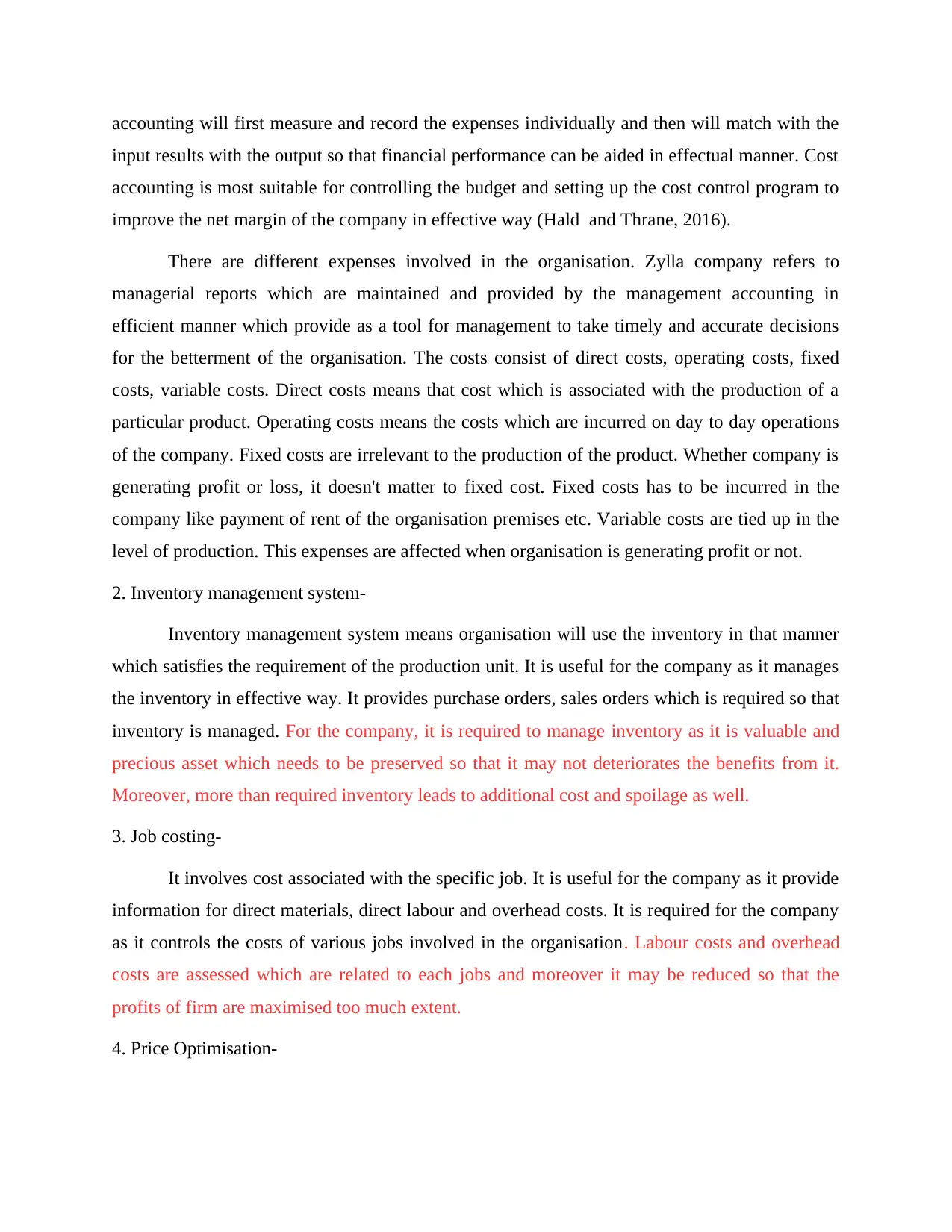
accounting will first measure and record the expenses individually and then will match with the
input results with the output so that financial performance can be aided in effectual manner. Cost
accounting is most suitable for controlling the budget and setting up the cost control program to
improve the net margin of the company in effective way (Hald and Thrane, 2016).
There are different expenses involved in the organisation. Zylla company refers to
managerial reports which are maintained and provided by the management accounting in
efficient manner which provide as a tool for management to take timely and accurate decisions
for the betterment of the organisation. The costs consist of direct costs, operating costs, fixed
costs, variable costs. Direct costs means that cost which is associated with the production of a
particular product. Operating costs means the costs which are incurred on day to day operations
of the company. Fixed costs are irrelevant to the production of the product. Whether company is
generating profit or loss, it doesn't matter to fixed cost. Fixed costs has to be incurred in the
company like payment of rent of the organisation premises etc. Variable costs are tied up in the
level of production. This expenses are affected when organisation is generating profit or not.
2. Inventory management system-
Inventory management system means organisation will use the inventory in that manner
which satisfies the requirement of the production unit. It is useful for the company as it manages
the inventory in effective way. It provides purchase orders, sales orders which is required so that
inventory is managed. For the company, it is required to manage inventory as it is valuable and
precious asset which needs to be preserved so that it may not deteriorates the benefits from it.
Moreover, more than required inventory leads to additional cost and spoilage as well.
3. Job costing-
It involves cost associated with the specific job. It is useful for the company as it provide
information for direct materials, direct labour and overhead costs. It is required for the company
as it controls the costs of various jobs involved in the organisation. Labour costs and overhead
costs are assessed which are related to each jobs and moreover it may be reduced so that the
profits of firm are maximised too much extent.
4. Price Optimisation-
input results with the output so that financial performance can be aided in effectual manner. Cost
accounting is most suitable for controlling the budget and setting up the cost control program to
improve the net margin of the company in effective way (Hald and Thrane, 2016).
There are different expenses involved in the organisation. Zylla company refers to
managerial reports which are maintained and provided by the management accounting in
efficient manner which provide as a tool for management to take timely and accurate decisions
for the betterment of the organisation. The costs consist of direct costs, operating costs, fixed
costs, variable costs. Direct costs means that cost which is associated with the production of a
particular product. Operating costs means the costs which are incurred on day to day operations
of the company. Fixed costs are irrelevant to the production of the product. Whether company is
generating profit or loss, it doesn't matter to fixed cost. Fixed costs has to be incurred in the
company like payment of rent of the organisation premises etc. Variable costs are tied up in the
level of production. This expenses are affected when organisation is generating profit or not.
2. Inventory management system-
Inventory management system means organisation will use the inventory in that manner
which satisfies the requirement of the production unit. It is useful for the company as it manages
the inventory in effective way. It provides purchase orders, sales orders which is required so that
inventory is managed. For the company, it is required to manage inventory as it is valuable and
precious asset which needs to be preserved so that it may not deteriorates the benefits from it.
Moreover, more than required inventory leads to additional cost and spoilage as well.
3. Job costing-
It involves cost associated with the specific job. It is useful for the company as it provide
information for direct materials, direct labour and overhead costs. It is required for the company
as it controls the costs of various jobs involved in the organisation. Labour costs and overhead
costs are assessed which are related to each jobs and moreover it may be reduced so that the
profits of firm are maximised too much extent.
4. Price Optimisation-
Paraphrase This Document
Need a fresh take? Get an instant paraphrase of this document with our AI Paraphraser
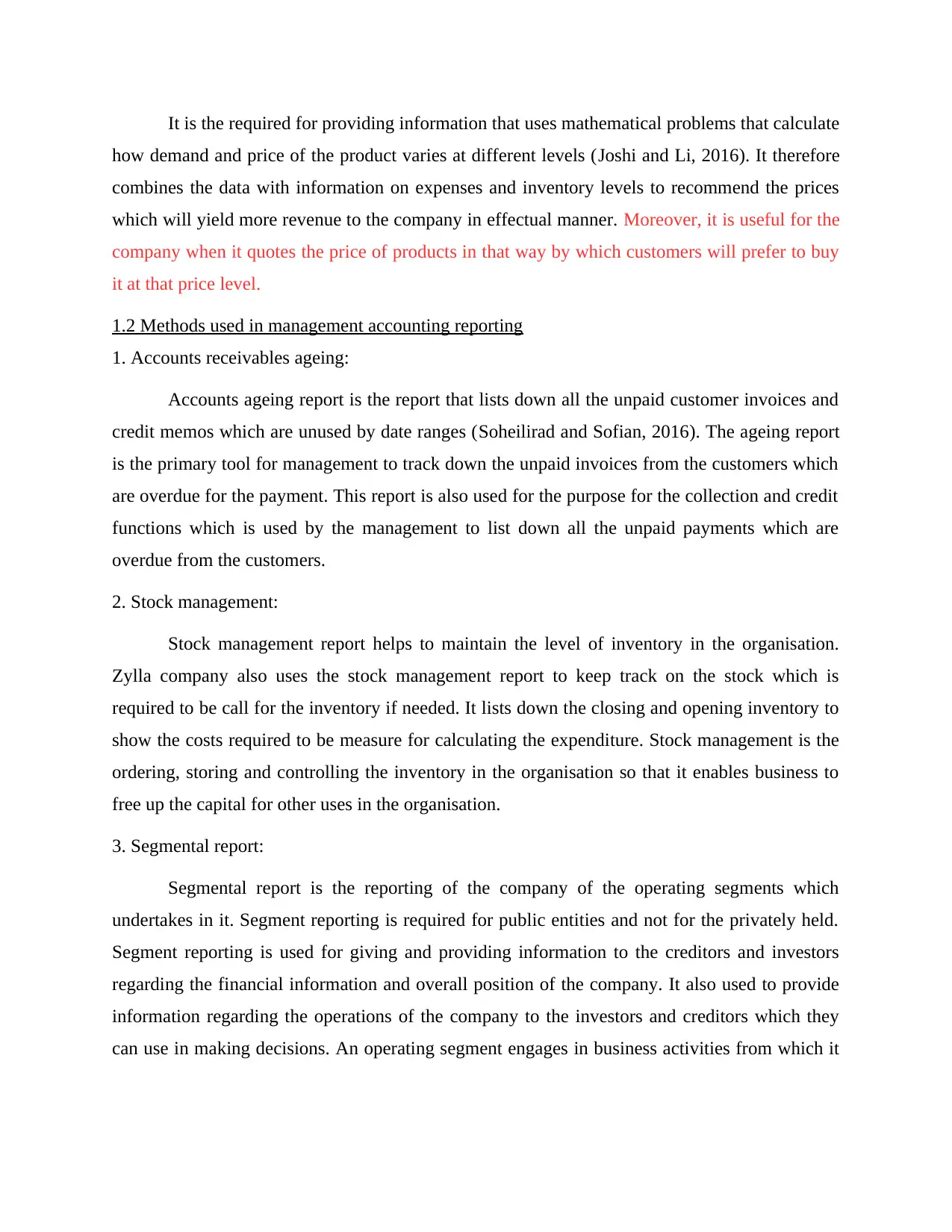
It is the required for providing information that uses mathematical problems that calculate
how demand and price of the product varies at different levels (Joshi and Li, 2016). It therefore
combines the data with information on expenses and inventory levels to recommend the prices
which will yield more revenue to the company in effectual manner. Moreover, it is useful for the
company when it quotes the price of products in that way by which customers will prefer to buy
it at that price level.
1.2 Methods used in management accounting reporting
1. Accounts receivables ageing:
Accounts ageing report is the report that lists down all the unpaid customer invoices and
credit memos which are unused by date ranges (Soheilirad and Sofian, 2016). The ageing report
is the primary tool for management to track down the unpaid invoices from the customers which
are overdue for the payment. This report is also used for the purpose for the collection and credit
functions which is used by the management to list down all the unpaid payments which are
overdue from the customers.
2. Stock management:
Stock management report helps to maintain the level of inventory in the organisation.
Zylla company also uses the stock management report to keep track on the stock which is
required to be call for the inventory if needed. It lists down the closing and opening inventory to
show the costs required to be measure for calculating the expenditure. Stock management is the
ordering, storing and controlling the inventory in the organisation so that it enables business to
free up the capital for other uses in the organisation.
3. Segmental report:
Segmental report is the reporting of the company of the operating segments which
undertakes in it. Segment reporting is required for public entities and not for the privately held.
Segment reporting is used for giving and providing information to the creditors and investors
regarding the financial information and overall position of the company. It also used to provide
information regarding the operations of the company to the investors and creditors which they
can use in making decisions. An operating segment engages in business activities from which it
how demand and price of the product varies at different levels (Joshi and Li, 2016). It therefore
combines the data with information on expenses and inventory levels to recommend the prices
which will yield more revenue to the company in effectual manner. Moreover, it is useful for the
company when it quotes the price of products in that way by which customers will prefer to buy
it at that price level.
1.2 Methods used in management accounting reporting
1. Accounts receivables ageing:
Accounts ageing report is the report that lists down all the unpaid customer invoices and
credit memos which are unused by date ranges (Soheilirad and Sofian, 2016). The ageing report
is the primary tool for management to track down the unpaid invoices from the customers which
are overdue for the payment. This report is also used for the purpose for the collection and credit
functions which is used by the management to list down all the unpaid payments which are
overdue from the customers.
2. Stock management:
Stock management report helps to maintain the level of inventory in the organisation.
Zylla company also uses the stock management report to keep track on the stock which is
required to be call for the inventory if needed. It lists down the closing and opening inventory to
show the costs required to be measure for calculating the expenditure. Stock management is the
ordering, storing and controlling the inventory in the organisation so that it enables business to
free up the capital for other uses in the organisation.
3. Segmental report:
Segmental report is the reporting of the company of the operating segments which
undertakes in it. Segment reporting is required for public entities and not for the privately held.
Segment reporting is used for giving and providing information to the creditors and investors
regarding the financial information and overall position of the company. It also used to provide
information regarding the operations of the company to the investors and creditors which they
can use in making decisions. An operating segment engages in business activities from which it
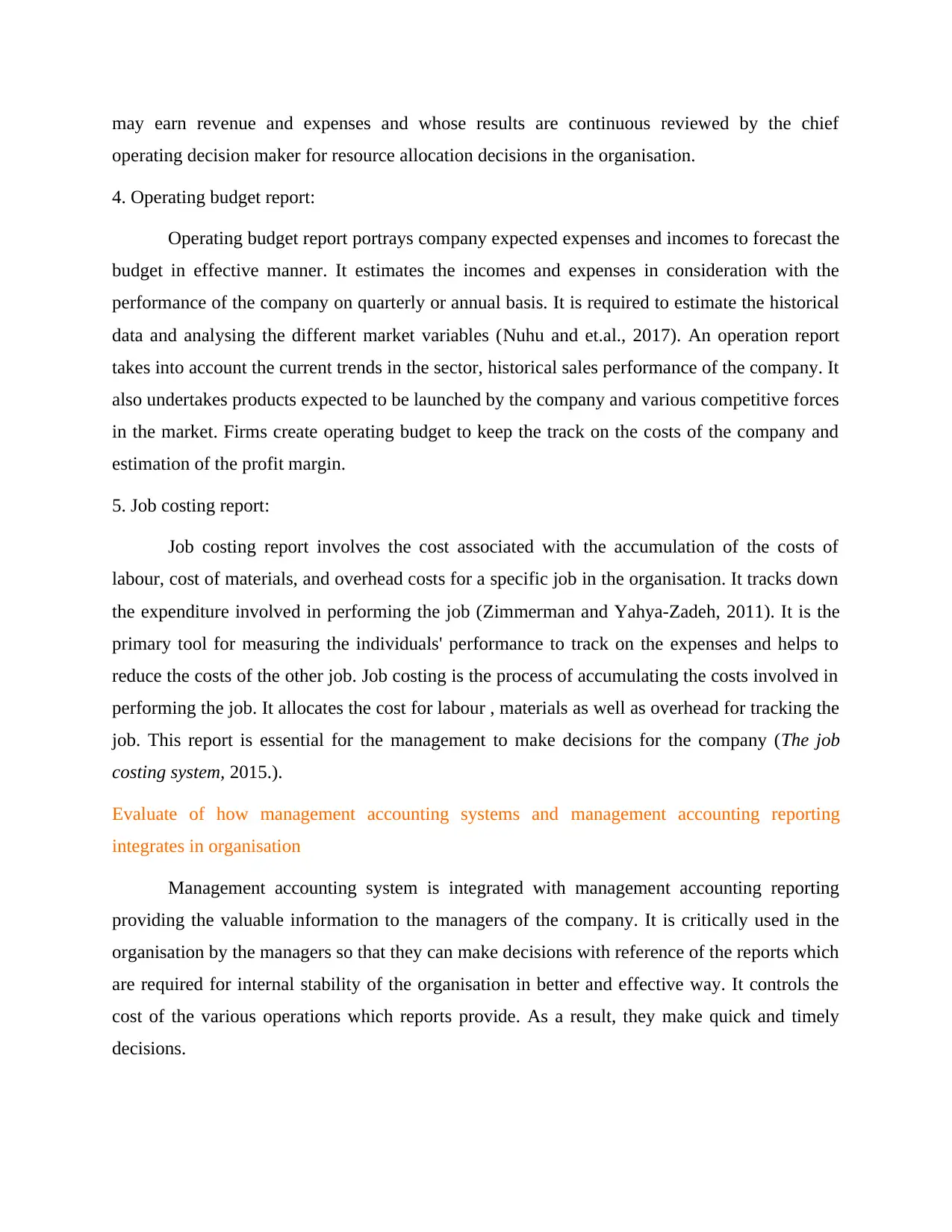
may earn revenue and expenses and whose results are continuous reviewed by the chief
operating decision maker for resource allocation decisions in the organisation.
4. Operating budget report:
Operating budget report portrays company expected expenses and incomes to forecast the
budget in effective manner. It estimates the incomes and expenses in consideration with the
performance of the company on quarterly or annual basis. It is required to estimate the historical
data and analysing the different market variables (Nuhu and et.al., 2017). An operation report
takes into account the current trends in the sector, historical sales performance of the company. It
also undertakes products expected to be launched by the company and various competitive forces
in the market. Firms create operating budget to keep the track on the costs of the company and
estimation of the profit margin.
5. Job costing report:
Job costing report involves the cost associated with the accumulation of the costs of
labour, cost of materials, and overhead costs for a specific job in the organisation. It tracks down
the expenditure involved in performing the job (Zimmerman and Yahya-Zadeh, 2011). It is the
primary tool for measuring the individuals' performance to track on the expenses and helps to
reduce the costs of the other job. Job costing is the process of accumulating the costs involved in
performing the job. It allocates the cost for labour , materials as well as overhead for tracking the
job. This report is essential for the management to make decisions for the company (The job
costing system, 2015.).
Evaluate of how management accounting systems and management accounting reporting
integrates in organisation
Management accounting system is integrated with management accounting reporting
providing the valuable information to the managers of the company. It is critically used in the
organisation by the managers so that they can make decisions with reference of the reports which
are required for internal stability of the organisation in better and effective way. It controls the
cost of the various operations which reports provide. As a result, they make quick and timely
decisions.
operating decision maker for resource allocation decisions in the organisation.
4. Operating budget report:
Operating budget report portrays company expected expenses and incomes to forecast the
budget in effective manner. It estimates the incomes and expenses in consideration with the
performance of the company on quarterly or annual basis. It is required to estimate the historical
data and analysing the different market variables (Nuhu and et.al., 2017). An operation report
takes into account the current trends in the sector, historical sales performance of the company. It
also undertakes products expected to be launched by the company and various competitive forces
in the market. Firms create operating budget to keep the track on the costs of the company and
estimation of the profit margin.
5. Job costing report:
Job costing report involves the cost associated with the accumulation of the costs of
labour, cost of materials, and overhead costs for a specific job in the organisation. It tracks down
the expenditure involved in performing the job (Zimmerman and Yahya-Zadeh, 2011). It is the
primary tool for measuring the individuals' performance to track on the expenses and helps to
reduce the costs of the other job. Job costing is the process of accumulating the costs involved in
performing the job. It allocates the cost for labour , materials as well as overhead for tracking the
job. This report is essential for the management to make decisions for the company (The job
costing system, 2015.).
Evaluate of how management accounting systems and management accounting reporting
integrates in organisation
Management accounting system is integrated with management accounting reporting
providing the valuable information to the managers of the company. It is critically used in the
organisation by the managers so that they can make decisions with reference of the reports which
are required for internal stability of the organisation in better and effective way. It controls the
cost of the various operations which reports provide. As a result, they make quick and timely
decisions.
⊘ This is a preview!⊘
Do you want full access?
Subscribe today to unlock all pages.

Trusted by 1+ million students worldwide
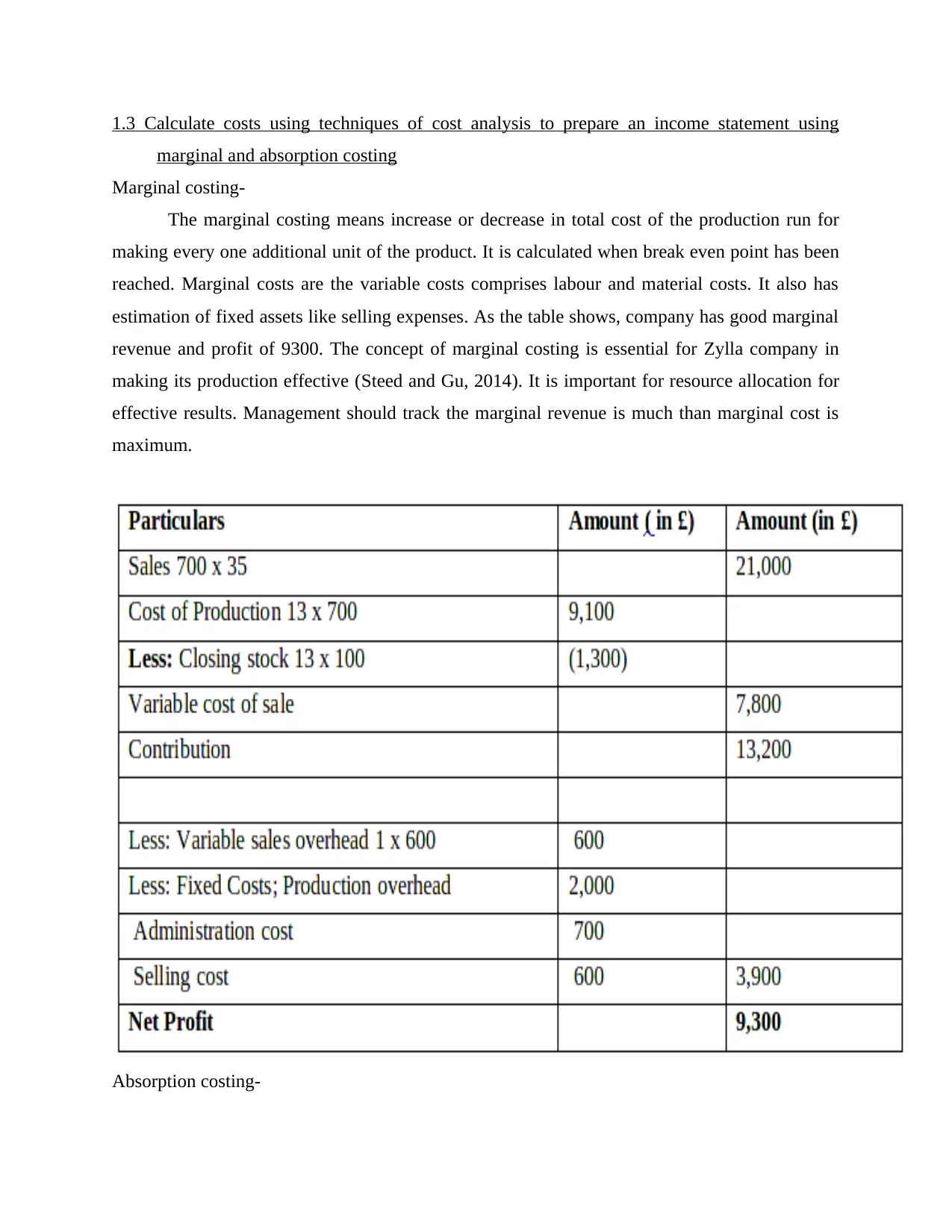
1.3 Calculate costs using techniques of cost analysis to prepare an income statement using
marginal and absorption costing
Marginal costing-
The marginal costing means increase or decrease in total cost of the production run for
making every one additional unit of the product. It is calculated when break even point has been
reached. Marginal costs are the variable costs comprises labour and material costs. It also has
estimation of fixed assets like selling expenses. As the table shows, company has good marginal
revenue and profit of 9300. The concept of marginal costing is essential for Zylla company in
making its production effective (Steed and Gu, 2014). It is important for resource allocation for
effective results. Management should track the marginal revenue is much than marginal cost is
maximum.
Absorption costing-
marginal and absorption costing
Marginal costing-
The marginal costing means increase or decrease in total cost of the production run for
making every one additional unit of the product. It is calculated when break even point has been
reached. Marginal costs are the variable costs comprises labour and material costs. It also has
estimation of fixed assets like selling expenses. As the table shows, company has good marginal
revenue and profit of 9300. The concept of marginal costing is essential for Zylla company in
making its production effective (Steed and Gu, 2014). It is important for resource allocation for
effective results. Management should track the marginal revenue is much than marginal cost is
maximum.
Absorption costing-
Paraphrase This Document
Need a fresh take? Get an instant paraphrase of this document with our AI Paraphraser
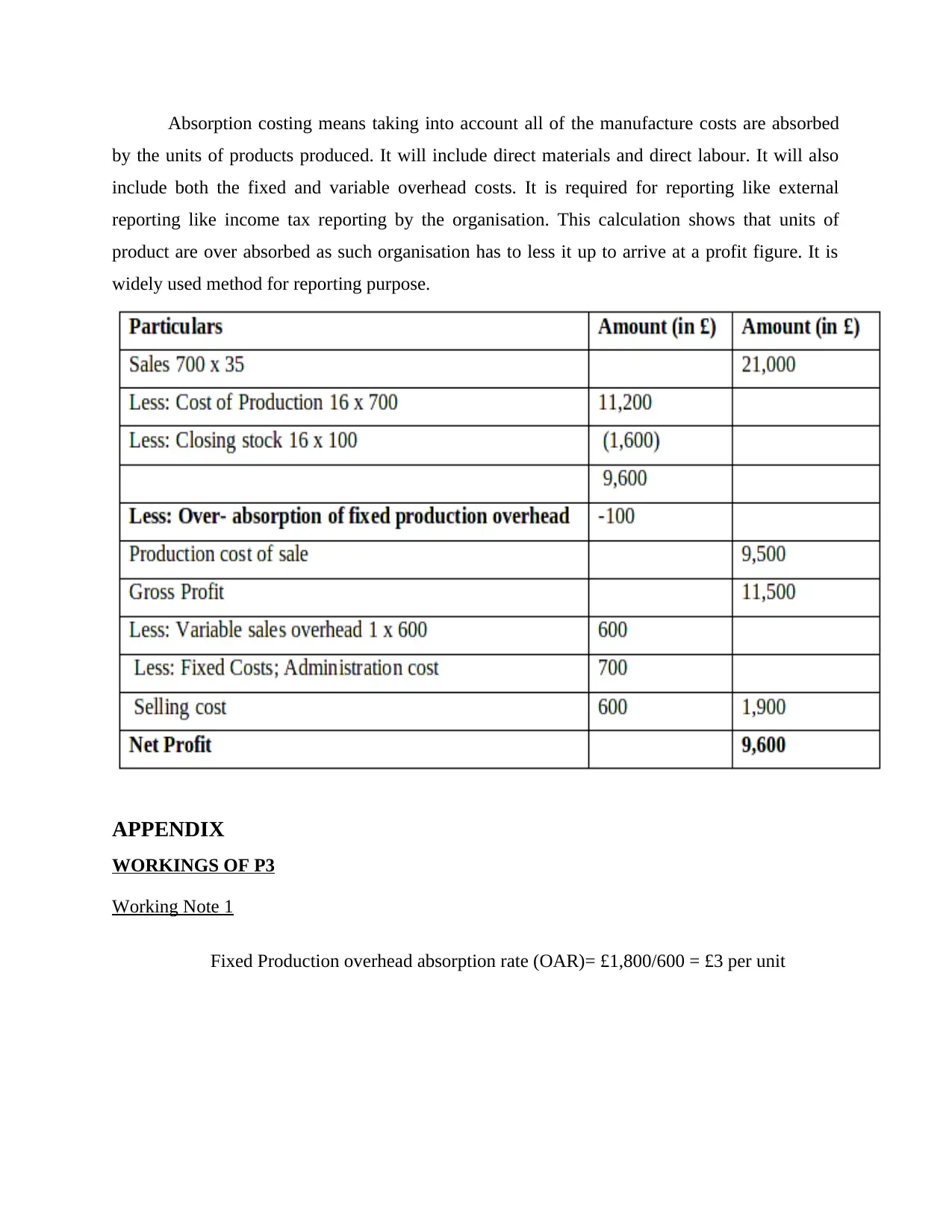
Absorption costing means taking into account all of the manufacture costs are absorbed
by the units of products produced. It will include direct materials and direct labour. It will also
include both the fixed and variable overhead costs. It is required for reporting like external
reporting like income tax reporting by the organisation. This calculation shows that units of
product are over absorbed as such organisation has to less it up to arrive at a profit figure. It is
widely used method for reporting purpose.
APPENDIX
WORKINGS OF P3
Working Note 1
Fixed Production overhead absorption rate (OAR)= £1,800/600 = £3 per unit
by the units of products produced. It will include direct materials and direct labour. It will also
include both the fixed and variable overhead costs. It is required for reporting like external
reporting like income tax reporting by the organisation. This calculation shows that units of
product are over absorbed as such organisation has to less it up to arrive at a profit figure. It is
widely used method for reporting purpose.
APPENDIX
WORKINGS OF P3
Working Note 1
Fixed Production overhead absorption rate (OAR)= £1,800/600 = £3 per unit
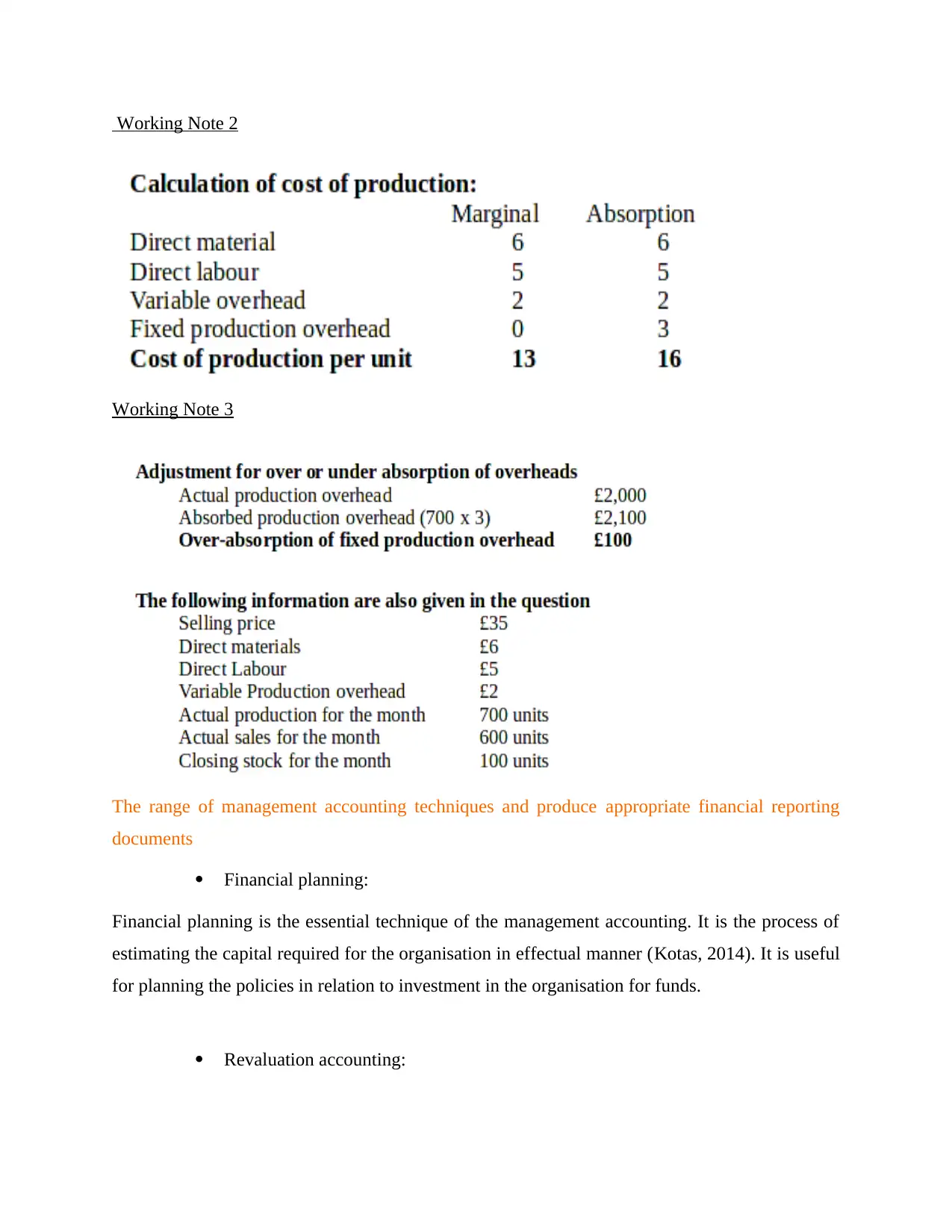
Working Note 2
Working Note 3
The range of management accounting techniques and produce appropriate financial reporting
documents
Financial planning:
Financial planning is the essential technique of the management accounting. It is the process of
estimating the capital required for the organisation in effectual manner (Kotas, 2014). It is useful
for planning the policies in relation to investment in the organisation for funds.
Revaluation accounting:
Working Note 3
The range of management accounting techniques and produce appropriate financial reporting
documents
Financial planning:
Financial planning is the essential technique of the management accounting. It is the process of
estimating the capital required for the organisation in effectual manner (Kotas, 2014). It is useful
for planning the policies in relation to investment in the organisation for funds.
Revaluation accounting:
⊘ This is a preview!⊘
Do you want full access?
Subscribe today to unlock all pages.

Trusted by 1+ million students worldwide
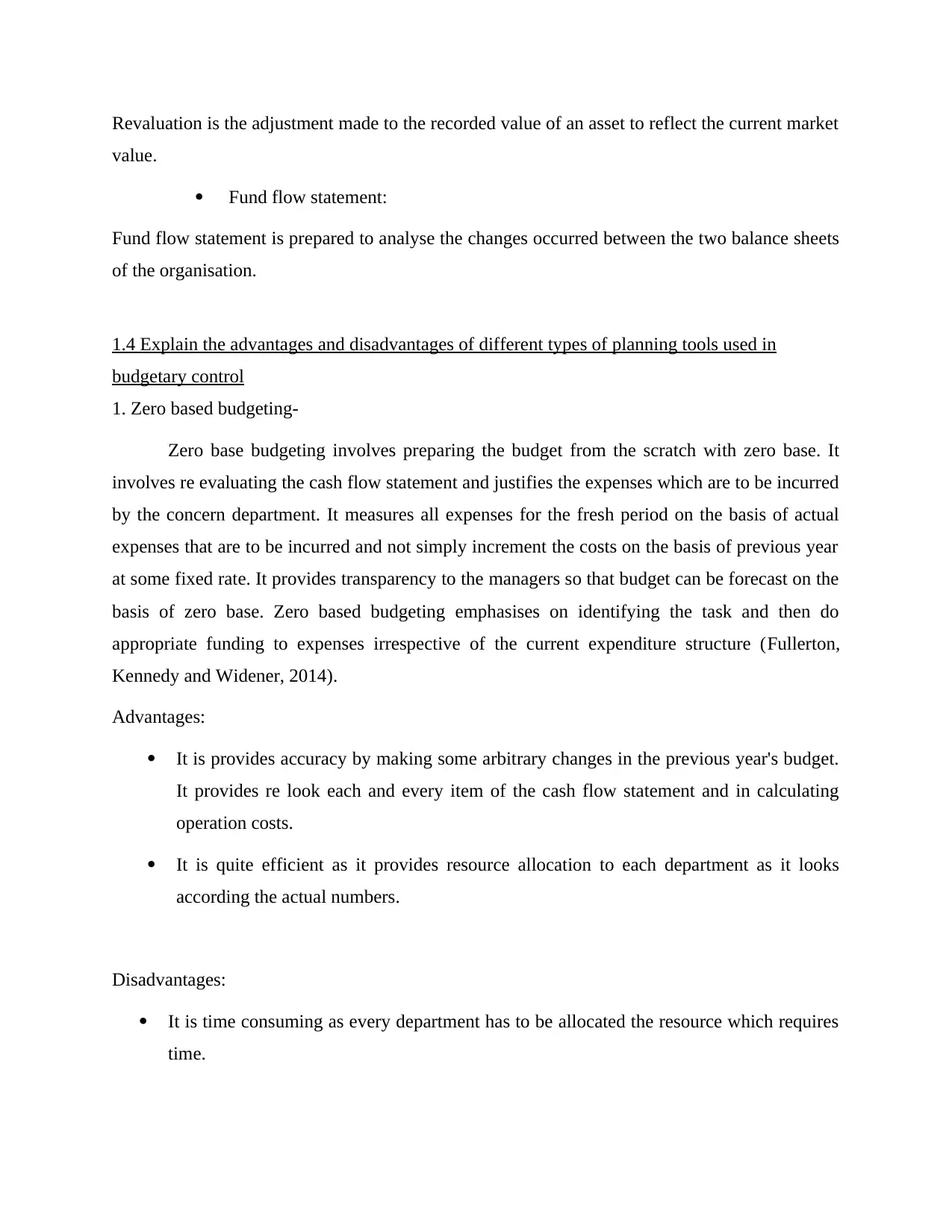
Revaluation is the adjustment made to the recorded value of an asset to reflect the current market
value.
Fund flow statement:
Fund flow statement is prepared to analyse the changes occurred between the two balance sheets
of the organisation.
1.4 Explain the advantages and disadvantages of different types of planning tools used in
budgetary control
1. Zero based budgeting-
Zero base budgeting involves preparing the budget from the scratch with zero base. It
involves re evaluating the cash flow statement and justifies the expenses which are to be incurred
by the concern department. It measures all expenses for the fresh period on the basis of actual
expenses that are to be incurred and not simply increment the costs on the basis of previous year
at some fixed rate. It provides transparency to the managers so that budget can be forecast on the
basis of zero base. Zero based budgeting emphasises on identifying the task and then do
appropriate funding to expenses irrespective of the current expenditure structure (Fullerton,
Kennedy and Widener, 2014).
Advantages:
It is provides accuracy by making some arbitrary changes in the previous year's budget.
It provides re look each and every item of the cash flow statement and in calculating
operation costs.
It is quite efficient as it provides resource allocation to each department as it looks
according the actual numbers.
Disadvantages:
It is time consuming as every department has to be allocated the resource which requires
time.
value.
Fund flow statement:
Fund flow statement is prepared to analyse the changes occurred between the two balance sheets
of the organisation.
1.4 Explain the advantages and disadvantages of different types of planning tools used in
budgetary control
1. Zero based budgeting-
Zero base budgeting involves preparing the budget from the scratch with zero base. It
involves re evaluating the cash flow statement and justifies the expenses which are to be incurred
by the concern department. It measures all expenses for the fresh period on the basis of actual
expenses that are to be incurred and not simply increment the costs on the basis of previous year
at some fixed rate. It provides transparency to the managers so that budget can be forecast on the
basis of zero base. Zero based budgeting emphasises on identifying the task and then do
appropriate funding to expenses irrespective of the current expenditure structure (Fullerton,
Kennedy and Widener, 2014).
Advantages:
It is provides accuracy by making some arbitrary changes in the previous year's budget.
It provides re look each and every item of the cash flow statement and in calculating
operation costs.
It is quite efficient as it provides resource allocation to each department as it looks
according the actual numbers.
Disadvantages:
It is time consuming as every department has to be allocated the resource which requires
time.
Paraphrase This Document
Need a fresh take? Get an instant paraphrase of this document with our AI Paraphraser
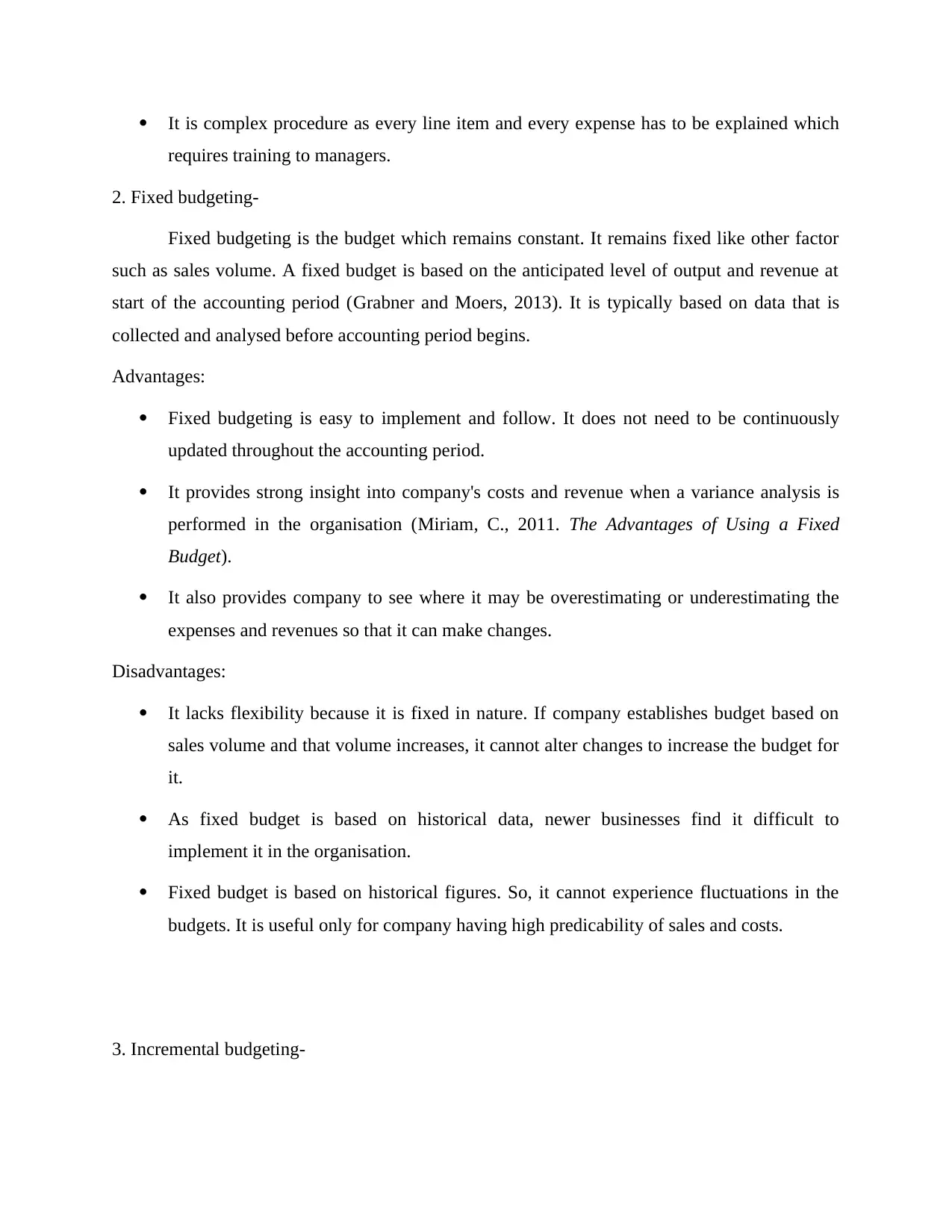
It is complex procedure as every line item and every expense has to be explained which
requires training to managers.
2. Fixed budgeting-
Fixed budgeting is the budget which remains constant. It remains fixed like other factor
such as sales volume. A fixed budget is based on the anticipated level of output and revenue at
start of the accounting period (Grabner and Moers, 2013). It is typically based on data that is
collected and analysed before accounting period begins.
Advantages:
Fixed budgeting is easy to implement and follow. It does not need to be continuously
updated throughout the accounting period.
It provides strong insight into company's costs and revenue when a variance analysis is
performed in the organisation (Miriam, C., 2011. The Advantages of Using a Fixed
Budget).
It also provides company to see where it may be overestimating or underestimating the
expenses and revenues so that it can make changes.
Disadvantages:
It lacks flexibility because it is fixed in nature. If company establishes budget based on
sales volume and that volume increases, it cannot alter changes to increase the budget for
it.
As fixed budget is based on historical data, newer businesses find it difficult to
implement it in the organisation.
Fixed budget is based on historical figures. So, it cannot experience fluctuations in the
budgets. It is useful only for company having high predicability of sales and costs.
3. Incremental budgeting-
requires training to managers.
2. Fixed budgeting-
Fixed budgeting is the budget which remains constant. It remains fixed like other factor
such as sales volume. A fixed budget is based on the anticipated level of output and revenue at
start of the accounting period (Grabner and Moers, 2013). It is typically based on data that is
collected and analysed before accounting period begins.
Advantages:
Fixed budgeting is easy to implement and follow. It does not need to be continuously
updated throughout the accounting period.
It provides strong insight into company's costs and revenue when a variance analysis is
performed in the organisation (Miriam, C., 2011. The Advantages of Using a Fixed
Budget).
It also provides company to see where it may be overestimating or underestimating the
expenses and revenues so that it can make changes.
Disadvantages:
It lacks flexibility because it is fixed in nature. If company establishes budget based on
sales volume and that volume increases, it cannot alter changes to increase the budget for
it.
As fixed budget is based on historical data, newer businesses find it difficult to
implement it in the organisation.
Fixed budget is based on historical figures. So, it cannot experience fluctuations in the
budgets. It is useful only for company having high predicability of sales and costs.
3. Incremental budgeting-
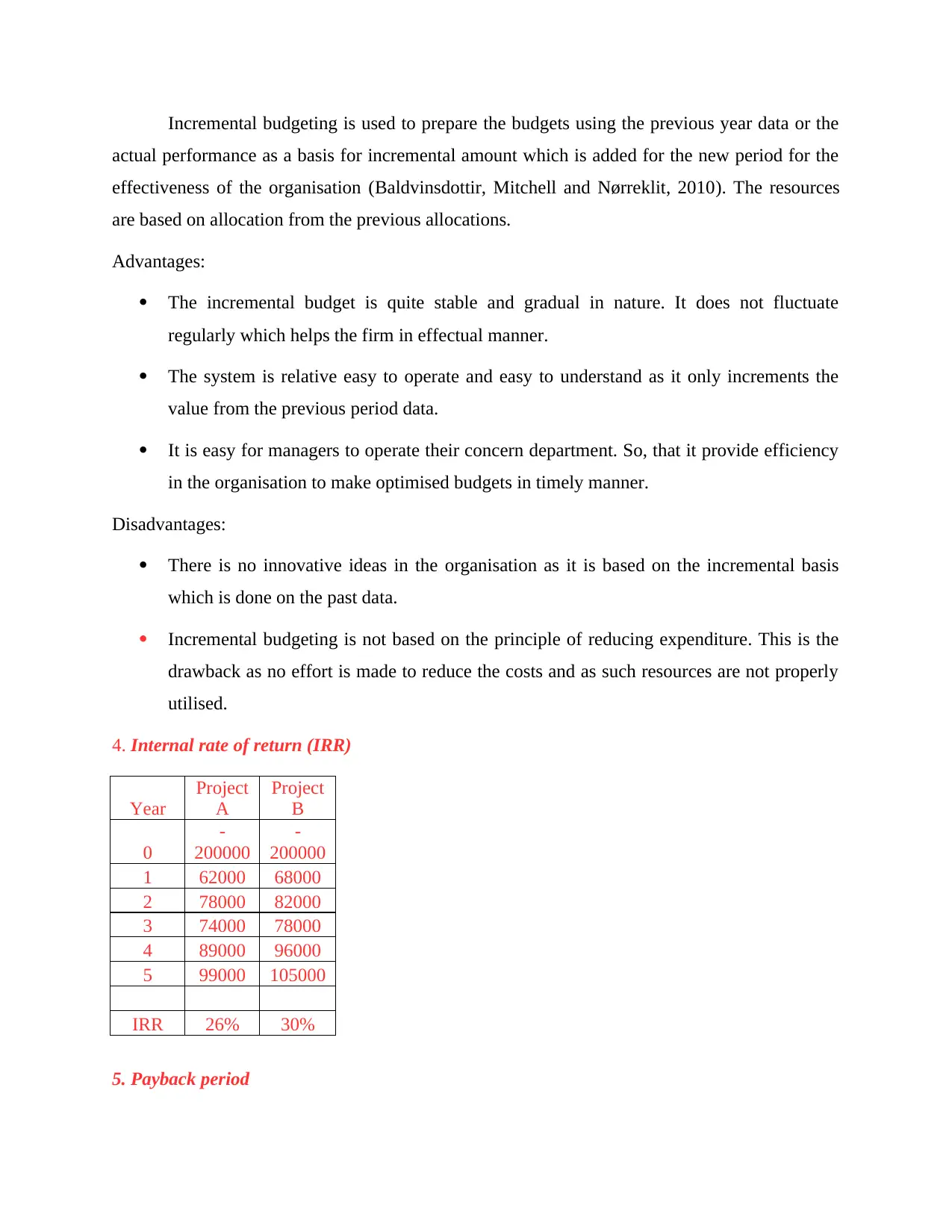
Incremental budgeting is used to prepare the budgets using the previous year data or the
actual performance as a basis for incremental amount which is added for the new period for the
effectiveness of the organisation (Baldvinsdottir, Mitchell and Nørreklit, 2010). The resources
are based on allocation from the previous allocations.
Advantages:
The incremental budget is quite stable and gradual in nature. It does not fluctuate
regularly which helps the firm in effectual manner.
The system is relative easy to operate and easy to understand as it only increments the
value from the previous period data.
It is easy for managers to operate their concern department. So, that it provide efficiency
in the organisation to make optimised budgets in timely manner.
Disadvantages:
There is no innovative ideas in the organisation as it is based on the incremental basis
which is done on the past data.
Incremental budgeting is not based on the principle of reducing expenditure. This is the
drawback as no effort is made to reduce the costs and as such resources are not properly
utilised.
4. Internal rate of return (IRR)
Year
Project
A
Project
B
0
-
200000
-
200000
1 62000 68000
2 78000 82000
3 74000 78000
4 89000 96000
5 99000 105000
IRR 26% 30%
5. Payback period
actual performance as a basis for incremental amount which is added for the new period for the
effectiveness of the organisation (Baldvinsdottir, Mitchell and Nørreklit, 2010). The resources
are based on allocation from the previous allocations.
Advantages:
The incremental budget is quite stable and gradual in nature. It does not fluctuate
regularly which helps the firm in effectual manner.
The system is relative easy to operate and easy to understand as it only increments the
value from the previous period data.
It is easy for managers to operate their concern department. So, that it provide efficiency
in the organisation to make optimised budgets in timely manner.
Disadvantages:
There is no innovative ideas in the organisation as it is based on the incremental basis
which is done on the past data.
Incremental budgeting is not based on the principle of reducing expenditure. This is the
drawback as no effort is made to reduce the costs and as such resources are not properly
utilised.
4. Internal rate of return (IRR)
Year
Project
A
Project
B
0
-
200000
-
200000
1 62000 68000
2 78000 82000
3 74000 78000
4 89000 96000
5 99000 105000
IRR 26% 30%
5. Payback period
⊘ This is a preview!⊘
Do you want full access?
Subscribe today to unlock all pages.

Trusted by 1+ million students worldwide
1 out of 18
Related Documents
Your All-in-One AI-Powered Toolkit for Academic Success.
+13062052269
info@desklib.com
Available 24*7 on WhatsApp / Email
![[object Object]](/_next/static/media/star-bottom.7253800d.svg)
Unlock your academic potential
Copyright © 2020–2025 A2Z Services. All Rights Reserved. Developed and managed by ZUCOL.





